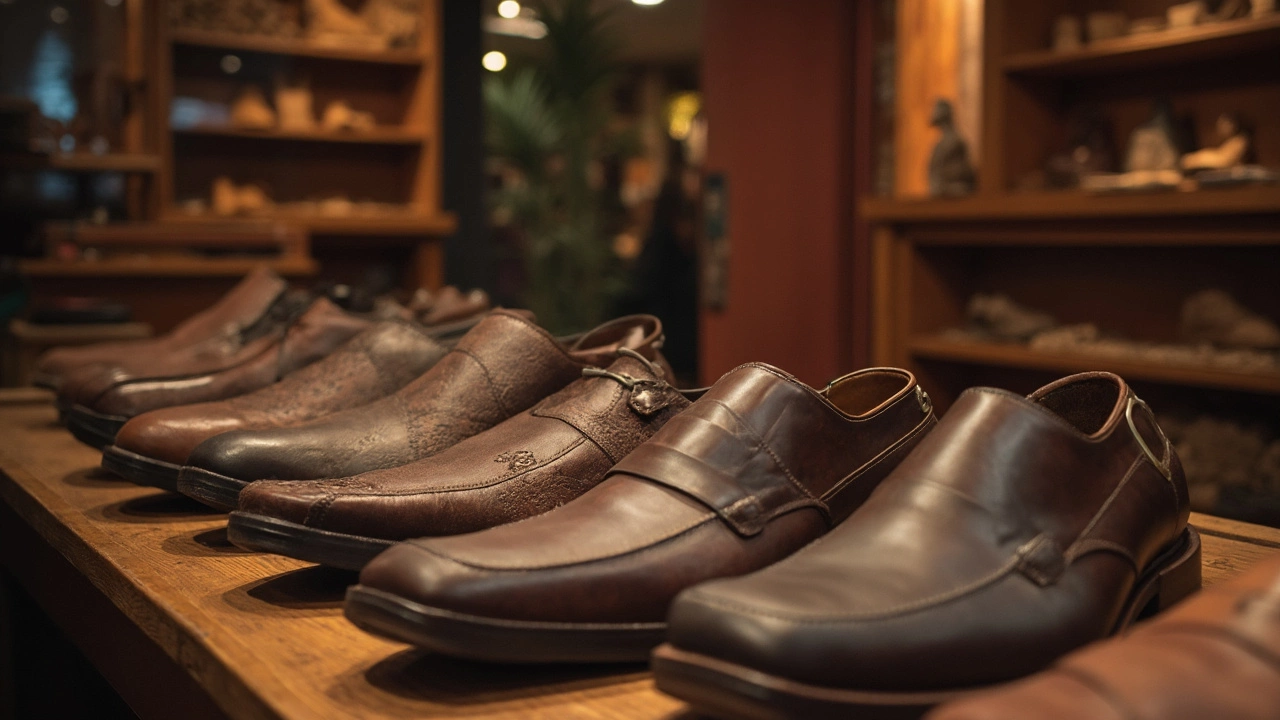The secret behind a great pair of leather shoes is the leather itself—sounds obvious, but it’s where most people mess up. Not all leather is created equal, and there’s a world of difference between the cheap stuff used in fast fashion and the real deal that lasts for years. Buy the right kind? Your shoes won’t just look sharp; they’ll mold to your feet and age like a favorite pair of jeans.
If you’ve ever flipped over a price tag and wondered why one pair costs twice as much as another, it’s probably about the leather. Full grain leather sits at the top—this is the top layer of the hide, complete with all the natural texture. Shoe nerds rave about it for a reason: it’s crazy durable, holds up to scuffs, and develops a rich patina as it ages. Not far behind is top grain leather, a little more processed, a bit softer, but still solid if you want something that looks smart right out of the box.
Spotting the good stuff isn’t always easy in a brightly-lit store or online pic. Here’s the trick: real quality leather feels firm yet supple, almost like your skin—it even smells different, deeper and richer than the synthetic versions. And press your thumb into it; premium leather slowly springs back, while lower grades just stay dented or feel plasticky.
- Types of Leather Used in Shoes
- What Makes Leather High Quality?
- Tips to Identify Premium Leather
- Caring for High Quality Leather Shoes
Types of Leather Used in Shoes
Shoe makers like to throw around a bunch of leather terms, so it’s easy to get lost if you’re not careful. Each type has its own pros and cons, and knowing the difference can save you from spending big on something that won’t last. Here’s the real breakdown on what you’ll find in leather shoes today.
- Full Grain Leather: This is the gold standard. It comes from the top part of the hide and keeps the natural grain, meaning it’s super strong and resists moisture well. It ages better than anything else, picking up a cool patina that just looks better over time.
- Top Grain Leather: Almost as good—but not quite. Some of the outer grain is sanded or buffed to make it smoother, so it’s softer and often looks more polished right out of the box. It’s easier to stain and won’t age quite as nicely as full grain, but it’s still a solid pick for people who want a cleaner look from day one.
- Genuine Leather: Sounds fancy, doesn’t it? Here’s the truth: ‘genuine’ just means it’s technically real leather, but it’s made from leftover pieces from the hide. It’s sanded, painted, and stamped to look the part, but won’t hold up to real use. Shoe brands use this for cheap, mass-produced shoes.
- Bonded Leather: This is basically leather dust pressed together with glue. It’s super cheap, used in bargain shoes and accessories, and will crack and fall apart quickly. Skip it if you’re after real quality.
- Suede/Nubuck: Both are made by sanding the inner split of the hide. Suede is soft and fuzzy, while nubuck is like a velvety version of full grain. They look cool, but they stain easily and need more care, so be ready for extra cleaning.
If you’re hunting for high quality leather in shoes, always look for full grain or sometimes top grain leather, depending on your budget and style. Here’s a comparison of the main types:
| Leather Type | Durability | Aging/Patina | Price Range |
|---|---|---|---|
| Full Grain | Excellent | Gets Better | High |
| Top Grain | Very Good | Good | Medium-High |
| Genuine | Fair | Minimal | Medium-Low |
| Bonded | Poor | None | Low |
Choosing the right type matters. Full grain and top grain cost more, but your shoes will thank you later. Anything labeled just ‘genuine’ or ‘bonded’ is usually cutting corners—best avoided if you care about real value.
What Makes Leather High Quality?
Ever wondered why some leather shoes last for decades and others fall apart in a year? It’s mostly about the quality of the leather. A few clear things set the good stuff apart.
First, high quality leather usually comes from the top layer of the hide, called full grain leather. This layer carries all the natural texture, or "grain." It hasn’t been sanded or buffed to remove marks, so what you see is what you get. Because the grain is intact, the leather is tougher and ages way better than other types.
The way leather gets tanned matters, too. Most top shoes use vegetable-tanned or high-grade chrome-tanned leather. Vegetable tanning is slower (sometimes up to two months), but it leads to richer color and better wear. Chrome tanning is quicker and still common, but quality depends on how it’s done and the original hide.
Another big deal is how few imperfections the original hide has. High-end leather shoes are usually cut from hides with fewer scars or scratches. The fewer the flaws, the less need for covering up with heavy dyes or coatings—which can take away from the leather’s natural look and feel.
- Thickness: Good leather is usually thicker, holding its shape instead of sagging or stretching out.
- Pliability: It should flex easily without cracking. Stiff or brittle leather usually signals lower quality.
- Pores and Texture: The best grades keep some visible pores and unique textures—no plastic shine or perfectly uniform appearance.
Here’s a quick breakdown of how common leather types stack up in shoe materials:
| Leather Type | Durability | Appearance Over Time | Typical Use |
|---|---|---|---|
| Full Grain | Very High | Develops patina, gets better | High-end shoes |
| Top Grain | High | Stays smooth, less patina | Dress shoes |
| Corrected Grain | Medium | May crack, stays similar | Budget shoes |
| Bonded Leather | Low | Peels, wears out quickly | Cheap shoes, belts |
One last tip: smell the leather if you can. Real high grade leather has a rich, earthy smell—cheap or fake leather often smells like plastic or chemicals. If a shoe store won’t let you get close enough for a sniff test, that’s a red flag by itself.

Tips to Identify Premium Leather
When you’re hunting for high quality leather, a quick glance won’t cut it. There are a few dead giveaways that separate good leather from the questionable stuff. Here’s what to keep an eye on so you don’t get fooled by clever marketing.
- Check the surface: Premium leather shoes made from full grain or top grain leather keep their natural marks and pores. If the grain pattern looks totally perfect and too smooth, it’s probably been buffed or coated, which knocks it down a grade.
- Feel it: Good leather feels tight but flexible—firm, not floppy. It should give when you press but not feel mushy or overly soft. If it feels plastic-like or cold, it’s either low grade or fake.
- The classic smell test: Nothing mimics real, high end leather’s rich, earthy smell. If your nose picks up a weird chemical, rubber, or plastic aroma, that’s a red flag for cheaper alternatives or even vinyl.
- Look at the edges: Full grain leather usually has edges that aren’t totally perfect—there might be some fuzz or unevenness. Pressed or finished leathers tend to have sharp, ultra-clean edges. When in doubt, rougher (not fraying) edges usually mean better leather.
- Check for patina: Good leather starts getting a cool patina within a couple of months of wear. If your shoes look the same year after year, they’re probably coated with finishes that block this natural aging.
If you have access to more info—like the shoe’s description or tag—look for phrases like “full grain leather” or “top grain leather.” Steer clear of terms like “genuine leather” or “bonded leather.” These sound promising but usually mean leftover scraps glued together, which won’t hold up over time.
| Type | Natural Feel | Patina Ability | Durability |
|---|---|---|---|
| Full Grain Leather | Yes | Excellent | Outstanding |
| Top Grain Leather | Yes (slightly processed) | Good | Very Good |
| Genuine Leather | No | Poor | Basic |
| Bonded Leather | No | Poor | Poor |
One bonus tip: if a brand is secretive about what leather they use, that’s never a good sign. Brands that use high quality leather and want your trust are usually proud to talk about their materials right up front.
Caring for High Quality Leather Shoes
Treating high quality leather right isn’t rocket science, but skipping the basics will wreck your shoes faster than you think. If you’ve invested in leather shoes made from full grain or top grain, a little care can literally double their lifespan.
The first rule? Keep them dry. Water is not your leather’s friend. If you get caught in rain, stuff your shoes with newspaper and let them air dry away from direct heat. Blow dryers and heaters dry out leather, making it stiff and prone to cracking.
- Clean them regularly. Use a soft brush or damp cloth to wipe away dirt after each wear. No need for fancy soaps—just gentle motions to avoid scratching.
- Condition every few weeks. A good leather conditioner stops the leather from drying out and helps it stay flexible. Rub a small amount in with a clean cloth; less is more.
- Polish to keep that shine. Choose a wax-based polish that matches your shoe color. This isn’t just for looks—polish adds a layer of protection from scuffs and water.
- Use shoe trees. Cedar shoe trees absorb moisture and help your shoes keep their shape. This simple step prevents creasing in top grain and full grain leathers.
- Rotate your pairs. Don’t wear the same shoes two days in a row. Give them at least a day to breathe and release moisture.
Ever wondered why premium brands insist on using leather soles? They breathe better—but they also need extra TLC. Clean and condition the soles as well, and use protective taps if you walk in city streets all day.
| Task | How Often |
|---|---|
| Light Cleaning | After Each Wear |
| Conditioning | Every 2-4 Weeks |
| Polishing | Once a Month |
| Sole Check/Protection | Every 3-4 Months |
If your leather shoes start to look dull or you spot little cracks, that’s your cue to condition. Don’t wait for serious damage to show up. These habits protect your investment, keep shoes looking sharp, and make sure you always step out in style.

